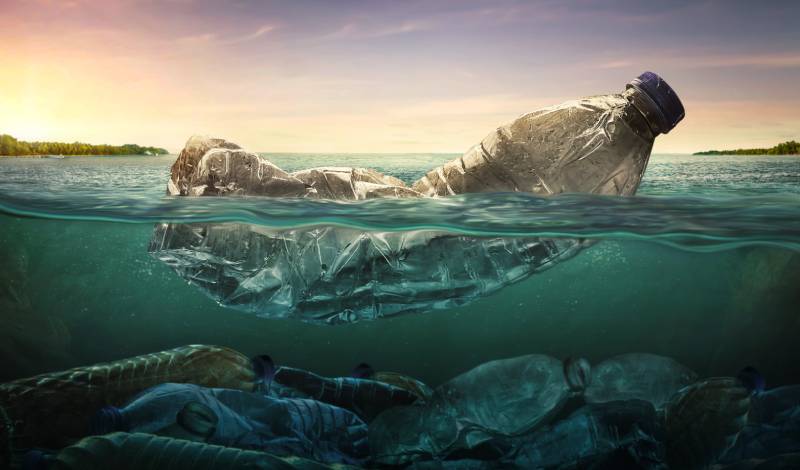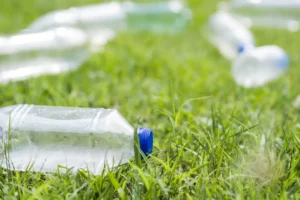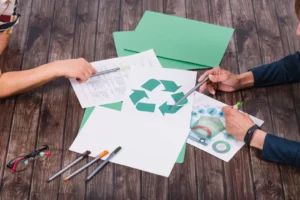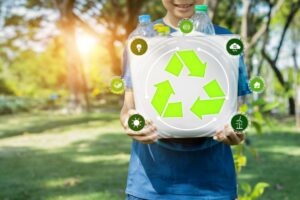Plastic pollution is destroying the environment by emitting harmful gasses into the atmosphere.
It’s polluting the oceans and the rivers just as much as it’s destroying the very air we breathe. When plastic is left unattended in the landfills, the decomposition of its components releases the CO2 into the environment which ultimately results in global warming & harming the delicate ecosystem.
When it comes to plastic production, it releases the same CO2 twice as much into the environment then it releases when it decomposes. In fact, some plastics like polyethylene generate twice the amount of CO2 than PET bottles or HDPE containers.
If you’re curious to learn how much plastic waste is damaging the environment, then here’s an article that outlines everything for you.
How Does Plastic Impact the Oceans?
Human-generated waste has significantly impacted marine ecosystems over thousands of years, resulting in creating a number of ecological challenges. Today, there’s almost 8 million metric tons of plastic being disposed off into the sea every year. Plastic is not only becoming fatal for humans, but it’s also becoming fatal for marine life just as much. Each year, thousands of sea creatures are found dead by getting entangled or wrongly ingesting plastic debris.
Researchers have found out that plastic reduces oxygen levels within the sea water which is one of the concerns why many sea creatures who were bound to live for long have shortened life cycles. It’s also researched that plastic can interfere with the hormones and genetic structure reducing the population of the marine animal by a considerable extent.
We have all heard of plankton from the infamous SpongeBob SquarePants. Plankton is an essential source in the food chain for many marine life animals & is a source of sustenance. Not only does it disrupt the marine ecosystem, but it also has a negative impact on the climate & creates global warming.
Microplastics: Another Source of Environmental Degradation
Microplastic is another form of plastic which is abundantly present in our environment. Almost 12 million metric tons of microplastic is found in the oceans, from the depth all the way to the surface. That’s approximately 5 trillion tons of plastic water bottles sent to the ocean every year.
Microplastics are small particles that originate from larger plastic debris such as plastic bags and bottles, or from industrial processes like wastewater treatment plants.
These tiny particles stay within the environment for decades which threatens not only marine life but also human life. The presence of microplastic has been documented in almost all the major oceans of the world. In fact, the way people are now disposing of microplastics, one can even find them in drinking water supplies which is a danger to human health. Its occurrence has become common in streams, lakes, ponds, rivers & even wetlands.
Carbon Emissions from Plastic Production
It’s no hidden fact that plastic production requires a significant amount of energy. When plastic is produced, it leaves off carbon dioxide and other greenhouse gases within the atmosphere. As more and more carbon dioxide is released, it forms hot temperature zones within the environment. It’s no hidden fact that production of plastic itself is a major contributor to the global carbon emissions. It equally contributes to environmental degradation.
Plastic breakdown also creates a lot of methane gas which is even more powerful than greenhouse gas and releases stronger carbon dioxide into the environment increasing the temperature. With the rise of plastic pollution, there’s no denying that it has become a major contributor to global warming. Therefore, it’s essential that necessary steps are taken in order to reduce the damage plastic can cause to the environment.
Pollution from Landfills
Plastic decomposition releases methane gas within the environment which leads to massive production of greenhouse gasses. Greenhouse gas is what contributes to climate change. As more and more plastic material is disposed off into the landfills, it leads to the release of hazardous elements in the atmosphere & emits large amounts of carbon dioxide within the environment. There are many other chemical compounds which are also released other than carbon dioxide into the landfills and are linked to respiratory illnesses and other serious health problems.
Besides, improper disposal practices can cause significant damage to local habitats and disrupt natural cycles within them. Leachate runoff from landfills carries toxins into nearby water sources such as rivers and streams, leading to environmental contamination and potentially affecting drinking water quality for humans and animals alike. It reduces our reliance on plastic & creates a negative impact on landfills.
Strategies to Reduce Plastic Pollution
Reducing our reliance on single-use plastics can help mitigate the environmental damage caused by plastic pollution. In order to reduce plastic pollution, individuals, businesses, and governments must all work together and develop strategies that reduce the amount of plastics in circulation.
One important strategy is to create incentives for businesses to use recycled materials instead of new ones in their products. Additionally, it is essential for governments to pass legislation that limits the production of single-use plastics and encourages citizens to buy reusable products. Furthermore, educational initiatives can be employed so people understand the importance of reducing their dependence on disposable items.
Another key strategy for reducing plastic waste is encouraging businesses to redesign packaging so they are more easily recyclable or compostable. Moreover, manufacturers should also be encouraged to switch from using petroleum-based plastics to bioplastics made from renewable resources like cornstarch or sugarcane bagasse which are much more eco-friendly than traditional plastic materials.
Finally, local communities should strive to increase public awareness about how plastic waste affects our environment and promote recycling programs which help divert waste from landfills into reuse and recycling centers.
Conclusion
The effects of plastic pollution on our climate are undeniable. It is like a domino effect, with the production of plastic leading to an increase in carbon emissions, and its subsequent disposal resulting in more pollution from landfills.
The oceans are not spared either, as microplastics have infiltrated even the most remote ecosystems. We must act now to reduce our reliance on single-use plastics if we are to mitigate these worrying trends.
Creative solutions such as reusable containers and biodegradable packaging can provide viable alternatives that help us break from this cycle of destruction. As individuals, it is essential that we take responsibility for our actions and reduce our plastic consumption for the sake of future generations.







